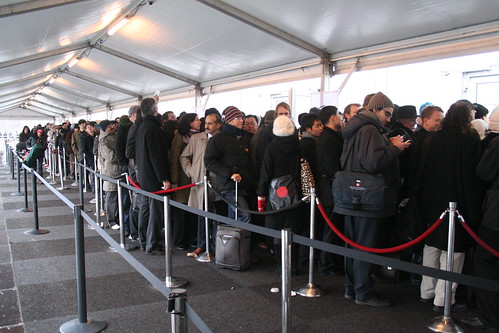It has taken this observer a few days (critically complemented by well overdue restful nights) to fairly assess the results of the Copenhagen fortnight. This delayed consideration is in part due to access, an issue I will raise first, not in order of importance, but due to the immediate impacts on my final days at the COP.
The UNFCCC Secretariat and COP host city have historically made Herculean efforts to ensure proceedings are transparent and accessible to all that have a legitimate stake in the process. Indeed the first week of COP15 was no exception to this admirable trend, even as Copenhagen’s Bella Center swelled under the strain of a record number of participants. However, burgeoning crowds of new arrivals in the COP’s second week confounded UNFCCC computer systems, strained already taxed logistics, and quickly exceeded the building’s occupancy limit. These capacity issues were further compounded as scores of high-level ministers and accompanying entourages streamed in for the latter week’s push. Finally, access went from difficult to impossible as security was heightened in the closing days of the COP to accommodate the almost 120 heads of state assembled to throw their weight behind the negotiations.
The sheer logistical challenge of accommodating so many eager participants marked an inflection point in the UNFCCC process in a number of respects, with COP15 representing the first significant limitation of access to civil society. While the organizers’ decision to pare down the ranks of admitted NGO observers from more than 10,000 to 7,000 and finally to just 300 sparked visceral outrage, an alternate emotionally-removed perspective would be right to note that these were not arbitrary restrictions and by many measures the action required to manage this heightened interest speaks to the ascendency of climate change from an obscure technical conversation to a top tier pressing issue of our day. Nevertheless, the fact that an unwieldy 45,000+ registered for the COP – an awkward number for any venue outside of a football stadium – inexorably leads to a conclusion that the UNFCCC COP process requires fundamental retooling.
Indeed, in the wake of spoiled expectations having very little to do with civil society’s harrumphing, some commentators are loudly arguing that the UNFCCC process is not just broken, but unfixable. Highlighting UN formality and decorum with specific reference to the fora’s fixation on unanimity and in turn the equal power it de facto grants nations large and small, these voices suggest diversity ultimately undermines expediency. Pointing to the limited number of participants (five named with 28 total signatories) in the summit’s vague but incrementally ambitious gesture towards an international agreement, the U.S. brokered Copenhagen Accord, the value of alternative venues for large emitters has again risen to the fore. In fact one such meeting has already been proposed by French President Nicholas Sarkozy in advance of the UNFCCC’s summer intersessional (tentatively the body’s next scheduled meeting).
Debate over the UNFCCC process will undoubtedly pick up in the New Year, but for now the preliminary noise being made on the topic provides an interesting backdrop for the subject of the part II of this post: the actual progress made at the COP.


Comments